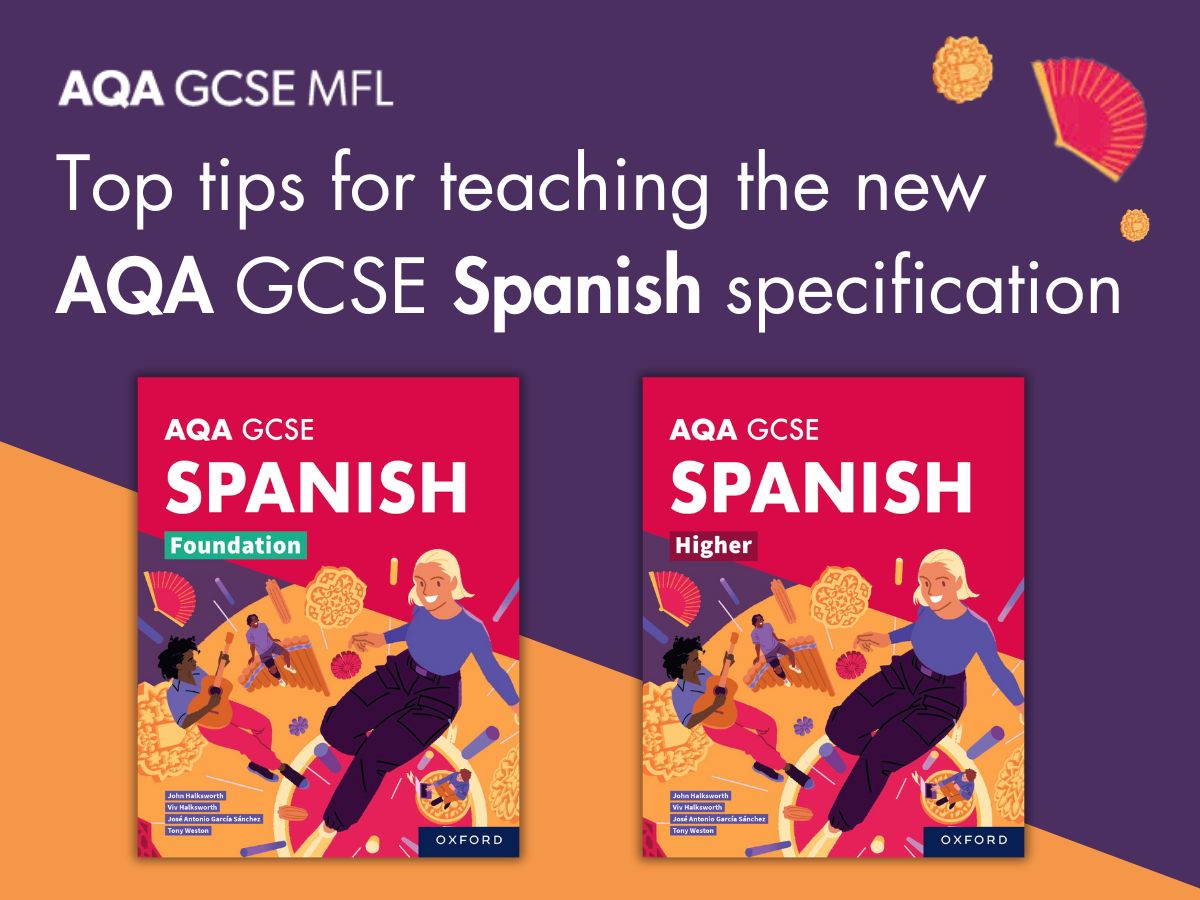By Tony Weston and José García, authors and Spanish teachers
From September 2024, thousands of budding young Hispanists across the country will once again be embarking on a two-year AQA GCSE Spanish course, one which they hope will bring them both enjoyment and success. The majority will, however, be unaware that their teachers will be delivering a new specification that will inevitably be compared to the current specification with optimism, a sense of renewal and opportunity, but also anxiety. Thankfully, it appears that the current specification will be succeeded by a specification which seeks to preserve the most successful parts of the one it replaces, while introducing new elements which build upon academic research and current trends.
The ‘3 pillars’ set in stone
In 2021, the Ofsted review into languages recommended that a languages curriculum should be carefully planned around ‘logical pupil progression in the ‘3 pillars’ of language: phonics, vocabulary, grammar – and the interplay between them.’ This publication led to many curriculum leaders (especially those anticipating an Ofsted deep-dive!) hastily revisiting schemes of work and reappraising their delivery of languages at Key Stage 3 (KS3). However, many no doubt realised that, for the most part, these pillars had always been at the core of their language teaching, both explicitly and implicitly.
So, how do each of these pillars support the new AQA GCSE Spanish specification?
- Phonics: The first reaction of most language teachers following a cursory glance at the draft foundation and higher listening exams for the new specification is: ‘it has a dictation!’. For this new section B task, students hear a sentence three times (the second time in short sections), then write down in Spanish exactly what they hear. This sort of exercise has been commonplace in Spanish schools for decades, where students learning English face the daunting challenge of deciphering multiple vowel sounds and perplexing spelling schemes.
The other stand-out addition to the new specification is the requirement to read aloud five sentences in Spanish in the speaking component of the exam. It seems logical, therefore, that Key Stage 3 Spanish teachers should introduce ample opportunity for dictation tasks and reading aloud if they don’t do so in the classroom already. But, the emphasis at this stage should be on enjoyment and engagement, while indirectly preparing for the GCSE exam (see the KS3 Spanish series, ¡Claro!, for example).
A low-anxiety classroom with clear instruction, well-pitched tasks, and praise and encouragement, will boost student participation and resilience. Furthermore, linguists consider Spanish to be a largely phonetic language. Regular oral practice and long-term exposure to suitable listening and reading material will allow students to build the skills and self-belief required to become a successful Spanish speaker. Of course, GCSE dictation and reading aloud tasks should therefore mirror the structure of the new assessments more closely. There are many examples of such tasks across a range of topics in the forthcoming AQA Spanish GCSE Student Books from Oxford University Press (Oxford) for the new specification, along with handy phonics boxes explaining many of the trickier sounds. Technology also has a significant role to play: teachers should remind students that their smartphones generally come equipped with an excellent voice recorder they can use to hear themselves read aloud, and also refer them to specific online Spanish resources, whether links to relevant video and audio, or more specialised GCSE language-learning platforms such as Kerboodle. - Vocabulary: The new AQA GCSE Spanish specification provides a vocabulary list largely taken from the 2000 most common words in Spanish, though it does contain some less common words linked to Hispanic culture, as well as some multi-word phrases. The list aims to reduce cognitive load for students learning the language, and so improves comprehension and spoken fluency. The Ofsted review into languages states:
“The 2000 most common words in a language represent more than 80% of the words in most written and spoken texts… clearly, an ability to understand and use these words has an immediate practical use. However, research also suggests that high-frequency words serve as ‘anchor points’ to help learners navigate texts, both spoken and written.”
Many common words that are no doubt used in your classroom at Key Stage 3, such as ‘conejo’, ‘ducharse’ or ‘morado’ do not appear on the list. This does not mean, however, that teachers should check each word in their schemes of work and remove those that are not on the list, nor should they reply, ‘Don’t worry, it’s not in the exam!’ when a student requests a less common word in Spanish! Rather, the list should prompt teachers to reflect on their schemes and the overarching principle of reducing cognitive load where possible. Besides, AQA has confirmed that the dictation task may use words from outside of the GCSE vocabulary list, and the need for extended oral and written responses means that words from outside this list will inevitably be covered both inside and outside the classroom. Nevertheless, the principal of recycling and retrieving the most common words to boost fluency remains. - Grammar: Grammatical awareness undoubtedly underpins a language learner’s sense of progress. Regular exposure to lots of suitable listening and reading material combined with appropriately timed and pitched grammar learning and drilling remains a winning blend for most teachers, despite ongoing debate in this area. Experienced teachers are aware that mastery of the extensive list of grammar points which appear at GCSE level is beyond many students. As ever, accurate use of common irregular verbs such as ser, estar, tener and the ability to identify and accurately conjugate a range of past, present and future tenses (particularly in the first and third persons), will remain key to success. They provide access to the higher mark bands on the speaking and writing papers, and facilitate comprehension of challenging listening and reading questions containing different time frames.
- General observations: Language teachers are all too aware of the difficulty of language GCSEs relative to other subjects, so any aspects of the new specification that embrace clarity and simplicity are most welcome. It will come as a relief to many that all rubrics will now be in English, and that the occasionally confusing ‘True, False, Not Mentioned’ questions have been removed. Dictations will reward communication as well as accuracy, so may even become a source of enjoyment and success for students. In the photo card discussion, there will no longer be requirements around how many topics to cover or how long must be spent on a topic; the teacher will be able to ask questions from any of the three topics within a theme so students can really showcase their speaking skills. Furthermore, the often tricky transactional role plays have been removed, leaving only informal conversation scenarios which often require opinions, and the notoriously difficult higher-tier translation into Spanish has been replaced by the separate sentences format already familiar to foundation candidates.
In terms of content, more contemporary and engaging topic areas can be explored under the ‘Popular culture’ theme. Among students, awareness of Hispanic culture has never been greater, in part as a result of the sustained growth of Spanish study in secondary schools, and also due to greater exposure in the media of Spanish and Latin American music, film, history, sport, food etc. The new AQA GCSE specification seeks to celebrate:
“The cultural diversity of languages in the countries and communities around the world, encouraging students to broaden their horizons, stepping beyond their own experiences and learning more about the countries and communities where the language is spoken.”
Spanish teachers need no invitation to use Hispanic cultural references to enthuse students, and it also provides an opportunity to embrace new and diverse examples. Oxford’s new AQA Spanish GCSE Student Book refers to interesting figures and events that aim to stand the test of time, such as the Spanish scientist and astronaut Sara García Alonso, art historian Eugenia Tenenbaum and Latin American festivals such as Feria de las Flores, Viña del Mar and Inti Raymi.
Language teachers are among the hardest working people in the education sector. The challenges they have faced are well-documented and – hopefully – increasingly understood by educational leaders. The new AQA GCSE Spanish specification could provide a well-needed boost to language-learning, and help nurture a love of Spanish in secondary schools.
Perhaps the most important role of a language teacher is to create a spark that fires their students’ passion for the subject, encouraging natural development and a thirst for learning. Given the richness and beauty of Hispanic culture, the exponential growth of the Spanish language, and the rise in power and influence of Spanish-speaking nations around the world, Spanish teachers are well placed to achieve this. Though there are multiple, complex factors that influence a student’s academic performance, it is those who are inspired and passionately curious who find greatest success.
Spanish teachers – enjoy your work!
You can access sample chapters from the new Spanish Student Books from Oxford by signing-up here, and the books are available to pre-order now in time for publication early 2024.
Oxford’s AQA GCSE Spanish resources are matched to the new AQA GCSE German specification* for first teaching from September 2024.
* Oxford’s Student Books and Kerboodle Books have been entered into an approval process with AQA.
Click to view our author blogs about implementing the new AQA GCSE German and AQA GCSE French 2024 specifications.

Tony Weston is a Curriculum Leader for Languages at a large high school in the Wirral and has over 17 years’ of teaching experience across Key Stages 3, 4 and 5. He is an author of Oxford’s KS3 ¡Claro! series, and has authored a range of Spanish textbooks, study and revision guides and practice papers at GCSE, IGCSE and A Level. Tony is also an experienced teacher with examining experience at GCSE and A Level.

José Antonio García Sánchez is a Deputy Head of a large Languages Department in a secondary school with 18 years’ teaching experience across all Key Stages. He is a creator of Oxford’s ¡Claro! series at Key Stage 3, and has authored an assortment of Spanish textbooks, film and literature guides and exam papers for GCSE, IGCSE, and the A Level curriculum. He is also a teacher with examining experience for both GCSE and A Level.

